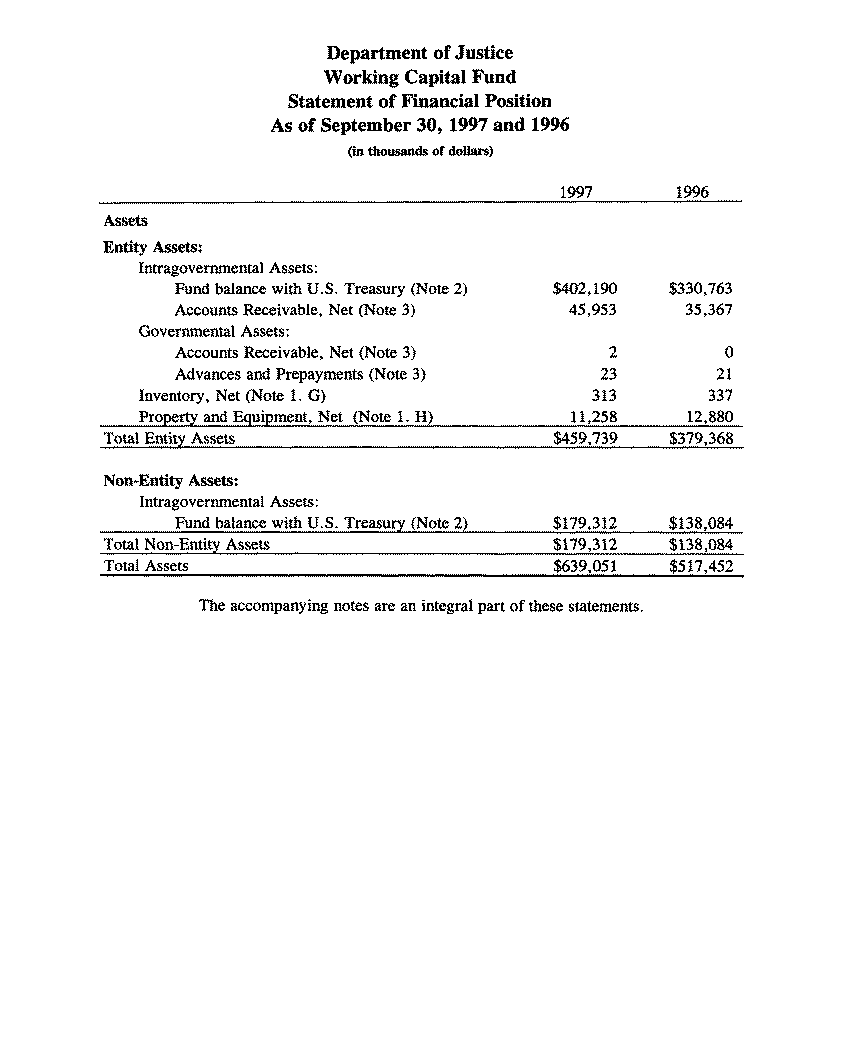
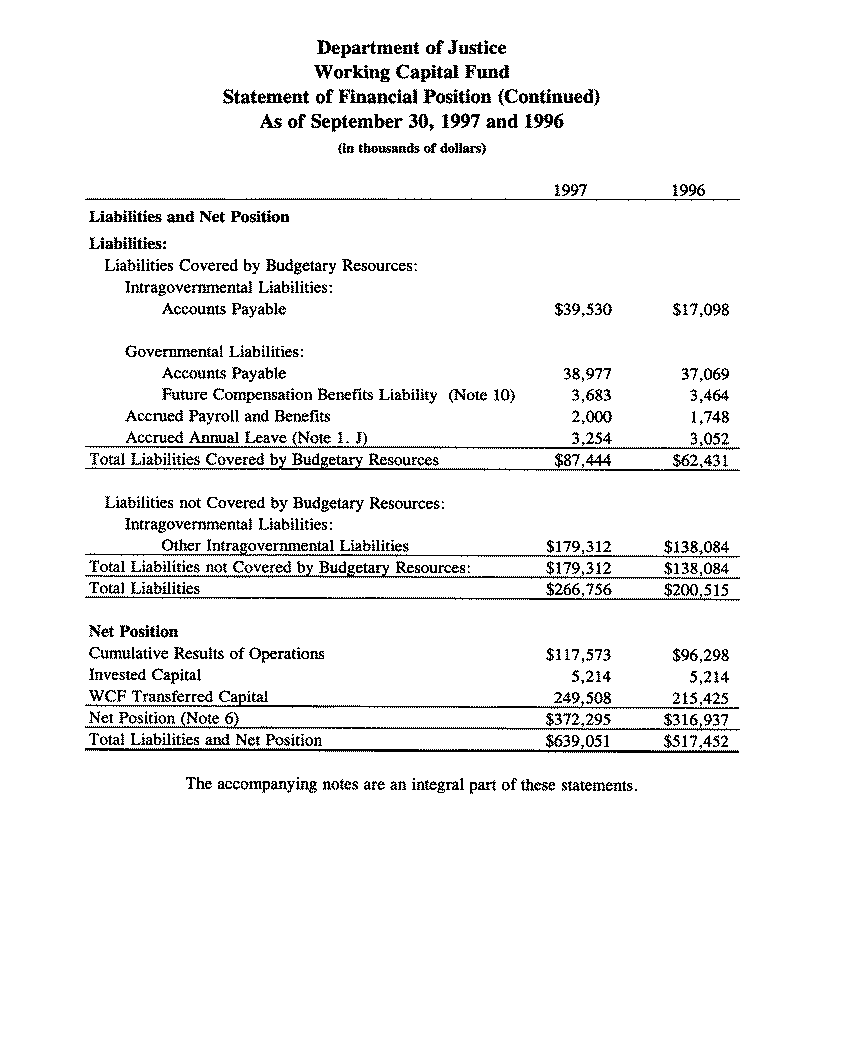
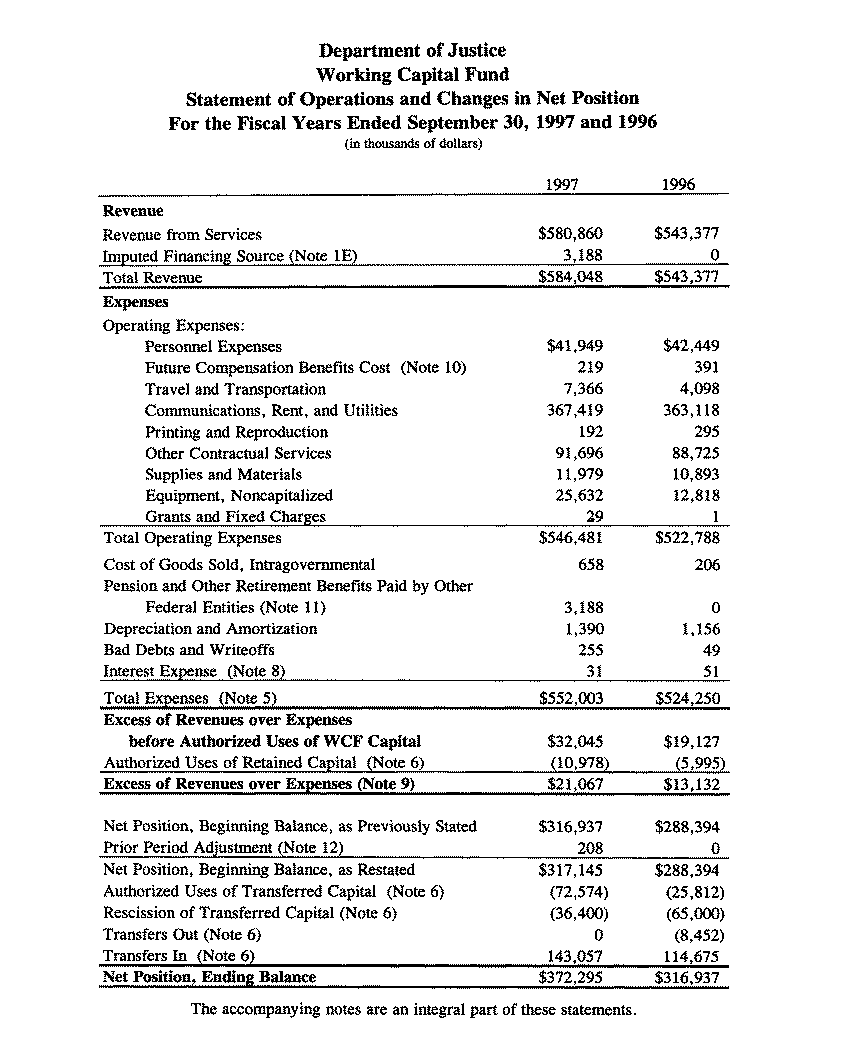
Principal Financial Statements
Notes to the Financial Statements
Note 1. Summary of Significant Accounting Policies
A. Basis of Presentation
These financial statements have been prepared to report the financial position and results of operations of the Working Capital Fund (WCF), as required by the Government Management Reform Act (GMRA) of 1994. These statements have been prepared from the books and records of the WCF in accordance with applicable portions of the Office of Management and Budget (OMB) Bulletins 94-01 and 97-01, Form and Content of Agency Financial Statements, dated November 16, 1993 and October 16, 1996, respectively, and WCF accounting policies which are summarized in this note. These statements are therefore different from the financial reports, also prepared by the WCF pursuant to OMB directives, that are used to monitor and control the WCF's use of budgetary resources. The OMB granted the Department a waiver of the OMB Bulletin 94-01 requirement to present the Statement of Cash Flows and the Statement of Budgetary Resources and Actual Expenses for FYs 1997 and 1996.
B. Reporting Entity
The WCF is a reporting entity within the Department of Justice (DOJ). The fund is a revolving fund established on January 2, 1975, under 28 U.S.C. § 527 to finance, on a break-even basis, administrative services provided by the Justice Management Division to Offices, Boards, Divisions and Bureaus of the Department and to other Federal agencies. These services are generally commercial functions, such as data processing, publications, building services, financial operations, employee data, telecommunications, property management and space management.
C. Basis of Accounting
Transactions are recorded on an accrual accounting basis and a budgetary basis. Under the accrual method, revenues are recognized when earned and expenses are recognized when a liability is incurred, without regard to receipt or payment of cash. Budgetary accounting facilitates compliance with legal constraints and controls over the use of federal funds.
D. Accounting Principles and Standards
The Statements of Federal Financial Accounting Standards (SFFAS) as of September 30, 1997 were used in the preparation of these financial statements. For those transactions that are not specifically addressed by these standards, the following hierarchy provided sources of generally accepted accounting principles for the Federal Government:
1. Individual standards agreed to by the Director of the OMB, the Controller General, and the Secretary of the Treasury and published by the OMB and the General Accounting Office.
2. Interpretations related to the SFFASs issued by the OMB in accordance with the procedures outlined in the OMB Circular A-134, "Financial Accounting Principles and Standards."
3. Requirements contained in applicable portions of OMB's Form and Content Bulletins 94-01 and 97-01.
4. Accounting principles published by other authoritative standard-setting bodies and other authoritative sources (a) in the absence of other guidance in the first three parts of this hierarchy, and (b) if the use of such accounting principles improve the meaningfulness of these financial statements.
E. Revenues and Other Financing Sources
The WCF receives the majority of the funding needed to support the program through reimbursement revenue. The WCF operates on a buyer/seller concept. Rates are established in advance to recover the actual costs of providing goods and services. Charges for services rendered are recognized as reimbursement income in the period earned.
The WCF also has the ability, with some restrictions (see Note 7), to retain and spend transferred funds and retained earnings. Funds made available and spent from these reserves augment the reimbursement process described above. This augmentation is presented as "Authorized Uses of Retained and Transferred Capital" in the Statement of Operations and Changes in Net Position. The Authorized Uses of Retained Capital recorded during Fiscal Years (FY) 1997 and 1996 were $11.0 million and $6.0 million, respectively. The Authorized Uses of WCF Transferred Capital recorded during FYs 1997 and 1996 were $72.6 million and $25.8 million, respectively.
Government entities often incur costs, such as for pensions, that are paid in total or in part by other entities. These constitute subsidized costs to be recognized by the receiving entity to the extent required by other accounting standards. The Statement of Federal Financial Accounting Standards Number Seven (SFFAS No.7), "Accounting for Revenue and Other Financing Sources", requires an imputed financing source to be recognized equal to the imputed costs. This offsets any effect of imputed costs on the net results of operations for the period.
F. Funds with the U.S. Treasury and Cash
Cash receipts and disbursements transactions are primarily relative to reimbursement agreements with WCF customers. There are no cash balances held outside the U.S. Treasury.
G. Inventories
All WCF inventories are held for sale. The WCF inventory is comprised, primarily, of new and rehabilitated office furniture to be sold in the normal operations of the WCF. The value of new stock is determined on the basis of acquisition cost. The value of rehabilitated stock is determined on the basis of rehabilitation and transportation costs. The inventory on hand at year end is reported at the lower of original cost (using the first-in, first-out method) or current market value. The recorded values are adjusted for the results of physical inventories conducted at the close of each FY presented. Expenditures or expenses are recorded as cost of goods sold when the inventory is consumed or sold.
H. Property and Equipment
| FY 1997 ($000) |
FY 1996 ($000) |
|
| Equipment | $19,861 | $19,192 |
| Leasehold Improvements | 12,640 | 12,400 |
| Software | 895 | 895 |
| Less: Accumulated Depreciation and Amortization | (22,138) | (19,607) |
| Property and Equipment, Net | $11,258 | $12,880 |
Acquisitions of $25 thousand and over are capitalized and depreciated/amortized using the straight-line method over the estimated useful lives of the assets which, for most WCF assets, range from 2 to 20 years. The WCF assets reported are composed mainly of leasehold improvements, computer, telecommunications, and photocopying equipment. Recorded amounts are periodically adjusted, based upon physical inventories.Acquisitions totaled $.8 million and $1.9 million for FYs 1997 and 1996, respectively. The WCF required no adjustment for capital leases (see Note 4) in FYs 1997 or 1996.
The land and buildings in which the WCF operates are provided by the General Services Administration (GSA), which charges the WCF a rent charge that approximates the commercial rental rates for similar properties. Therefore, depreciation on buildings and equipment provided by the GSA is not recognized by the WCF.
Certain improvements to leased property are capitalized and amortized over the lease period or the estimated useful period of the improvements, whichever is shorter. Leasehold improvements at September 30, 1997, and 1996, respectively, represent costs associated with improvements made to the Justice Data Center located in Rockville, Maryland. The computer facility became operational in September 1989, and the initial leasehold improvements ($3.2 million) are currently being amortized over an eight-year period beginning in October 1989. The first phase of the Rockville facility upgrades began with an architectural and engineering study ($860 thousand) which was completed during FY 1993 and began a two-year amortization schedule on October 1, 1993. The implementation of the upgrades continued in FY 1994 and included $1.5 million in leasehold improvements which began a twelve-year amortization schedule as of October 1, 1994. During FY 1995, an additional $6.6 million was expended for Rockville facility leasehold improvements which began an eleven-year amortization schedule as of October 1, 1995. During FY 1996, an additional $353 thousand was expended for Rockville facility leasehold improvements which began a ten-year amortization schedule as of October 1, 1996. During FY 1997, an additional $240 thousand was expended for Rockville facility leasehold improvements. These improvements will begin a nine-year amortization schedule as of October 1, 1997.
I. Liabilities
Liabilities represent the amount of monies or other resources that are likely to be paid by the WCF as the result of a transaction or event that has already occurred. However, no liability can be paid by the WCF absent proper budget authority. See Note 10 for disclosure of the Future Compensation Benefits Liability. Unlike Federal appropriated activities, the WCF funds its leave liabilities. Therefore, all the WCF liabilities are covered by budgetary resources, with one exception. The Debt Collection Management Activity, within the WCF, monitors a clearing account, U.S. Treasury Fund Symbol 15F3885, which represents restricted undisbursed civil and criminal debt collections that are administered by but not available to the WCF. The balance in this account is classified as a Non-Entity Asset on the WCF Statement of Financial Position and the corresponding intragovernmental liability is not covered by WCF budgetary resources.
J. Annual, Sick, and Other Leave
Annual leave is accrued as it is earned and the accrual is reduced as leave is taken. Each year, the balance in the accrued annual leave liability account is adjusted to reflect current pay rates. Sick leave and other types of nonvested leave are expensed as taken.
K. Retirement Plan
With few exceptions, employees hired before January 1, 1984, are covered by the Civil Service Retirement System (CSRS) and employees hired after that date are covered by the Federal Employees Retirement System (FERS). For employees covered by the CSRS, the WCF contributes 7 percent of the employee's gross pay. For employees covered by the FERS, the WCF contributes approximately 13 percent. The WCF does not report CSRS or FERS assets, accumulated plan benefits, or unfunded liabilities, if any, which may be applicable to WCF employees. Such reporting is the responsibility of the Office of Personnel Management.
However, beginning with FY 1997, the Statement of Federal Financial Accounting Standards No. 5, "Accounting for Liabilities of the Federal Government," requires employing agencies to recognized the full cost of pension and other retirement benefits during their employees' active years of service (see Note 11).
All employees are eligible to contribute to the Federal Thrift Savings Plan (TSP). For those employees covered by the FERS, a TSP is automatically established, and the WCF is required to contribute an additional 1 percent of gross pay to this plan and match employee contributions up to 4 percent. No matching contributions are made to the TSPs established by the CSRS employees.
L. Comparative Data
The FY 1996 WCF financial statements were reclassified and restated to conform with the FY 1997 presentation.
Note 2. Fund Balance With the U.S. Treasury
The amounts reported for FYs 1997 and 1996 represent the unexpended cash balance on the Department's books for the WCF at September 30 of each FY presented. For Entity Assets, the variance from the actual U.S. Treasury balance for Fund Symbol 15X4526 (WCF) is recorded as Disbursements in Transit on the Department's books for U.S. Treasury reporting requirements. The following table presents the composition of the Fund Balance With the U.S. Treasury, per the Statement of Financial Position, the Disbursements in Transit, and the Fund Balance With the U.S. Treasury, per the FMS Form 2108, Year-End Closing Statement. The table also includes the U.S. Treasury balance for Fund Symbol 15F3885, which represents restricted undisbursed civil and criminal debt collections. The 15F3885 balance is administered by but not available to the WCF. Therefore, the 15F3885 balance is classified as a Non-Entity Asset on the WCF Statement of Financial Position.
| FY 1997 ($000) | FY 1996 ($000) |
|
| Obligated Balance | $187,286 | $153,990 |
| Unobligated Balance, Available | 169,201 | 62,098 |
| Unobligated Balance, Unavailable (P.L. 104-208) | 45,703 | 114,675 |
| Entity Fund Balance with Treasury (15X4526) | 402,190 | 330,763 |
| Non-Entity Fund Balance with Treasury (15F3885) | 179,312 | 138,084 |
| Total Fund Balance with Treasury per WCF Records | 581,502 | 468,847 |
| Less items not included in the FMS Form 2108 for 15X4526: | ||
| Non-Entity Fund Balance with Treasury (15F3885) | (179,312) | (138,084) |
| Disbursements in Transit | (38) | (21) |
| Fund Balance with Treasury per FMS Form 2108 | $402,152 | $330,742 |
Note 3. Accounts Receivable, Net
| FY 1997 ($000) |
FY 1996 ($000) |
|
| Intragovernmental Assets: | ||
| Accounts Receivable | $46,759 | $35,919 |
| Less: Allowance for Doubtful Accounts | (806) | (552) |
| Accounts Receivable - Intragovernmental, Net | $45,953 | $35,367 |
| Governmental Assets: | ||
| Accounts Receivable | $13 | $9 |
| Less: Allowance for Doubtful Accounts | (11) | (9) |
| Accounts Receivable - Governmental, Net | $2 | $0 |
Net Accounts Receivable include reimbursement and refund receivables due from Federal agencies and others, less the allowance for doubtful accounts, as shown in the preceding table. The allowance for doubtful accounts represents estimated uncollectible amounts billed or billable to Federal agencies and others for services rendered by the WCF during FYs 1992 through 1997. The Department continues its efforts to resolve disputes and collect the amounts billed. Travel and Relocation Advances due from Federal employees represent small Governmental Assets which have been presented previously as part of the Governmental Assets -Account Receivable balance. These advances amount to $22.5 thousand for FY 1997 and $21.1 thousand in FY 1996.
Note 4. Leases
Capital Leases: The WCF has no leases which qualify as Capital Leases.
Operating Leases: The WCF has no material non-cancelable Operating Leases. The buildings in which the Department operates are leased by the General Services Administration (GSA), and the Department is charged rent intended to approximate commercial rates. The Department allocates a portion of these rent charges to the WCF according to the amount of space used by the WCF Operations. The WCF rent charges for FYs 1997 and 1996 totaled $7.8 million and $8.0 million, respectively. The following table presents the planned WCF rental charges through FY 2000. The amounts shown for FYs 1998 through 2000 are estimates due to ongoing rent negotiations with the GSA.
| Estimated Future Rental Payments for the WCF: | ($000) |
| FY 1998 (estimate) | $ 8,285 |
| FY 1999 (estimate) | 8,807 |
| FY 2000 (estimate) | 9,036 |
| Total Estimated Future Rental Payments | $26,128 |
Note 5. Expenses by WCF Activity
| FY 1997 ($000) |
FY 1996 ($000) |
|
| Data Processing Services (DPS) | $ 86,729 | $ 73,439 |
| Telecommunications Services (TSS) | 90,709 | 85,850 |
| Financial Management Systems (FMS) | 13,625 | 11,544 |
| Human Resource Systems (HRS) | 14,394 | 12,812 |
| Asset Forfeiture Management | 930 | 783 |
| Justice Building Services | 4,468 | 9,198 |
| Mail, Audiovisual, and Publications Services | 12,581 | 9,827 |
| Property Management | 970 | 299 |
| Space Management | 290,690 | 279,451 |
| Library Acquisition Services | 9,901 | 9,316 |
| Personnel Services | 5,224 | 3,722 |
| President's Prevention Council Office | (113) | 545 |
| Debt Collection Management | 18,233 | 27,024 |
| Subtotal | 548,341 | 523,810 |
| Allowance for Doubtful Accounts Receivable (Note 3) | 255 | 49 |
| Pension Expense | 3,188 | 0 |
| Future Compensation Benefits Liability (Note 10) | 219 | 391 |
| Total Expenses by WCF Activity | $552,003 | $524,250 |
Note 6. Net Position
The following table presents the Net Position for the WCF, which is entirely within the revolving fund category.
| Cumulative Results of Operations: | FY 1997 ($000) |
FY 1996 ($000) |
| Cumulative Results of Operations (FY 1991 and prior) | $ 2,844 | $ 2,844 |
| Retained Capital from WCF Operations | 43,513 | 48,845 |
| Retained Capital from WCF Debt Collection Activities | 71,216 | 44,609 |
| Total Cumulative Results of Operations | 117,573 | 96,298 |
| Invested Capital | 5,214 | 5,214 |
| Transferred Capital | 249,508 | 215,425 |
| Net Position | $372,295 | $316,937 |
The Net Position for the WCF is comprised of the following components:
- Cumulative Results of Operations - the difference between financing sources and expenses less authorized transfers to Retained Capital and funds returned to the U.S. Treasury.
- Retained Capital from WCF Operations - the net value of authorized transfers from Cumulative Results of Operations pursuant to the FY 1992 Appropriations Act, P.L. 102-140 (limited to 4 percent each Fiscal Year).
- Retained Capital from WCF Debt Collection Activities - the net value of authorized transfers from Cumulative Results of Operations pursuant to the FY 1994 Appropriations Act, P.L. 103-121.
- Invested Capital - the net value of property transferred to or from the WCF without reimbursement during FYs 1990 and prior. The Invested Capital Account includes a one time $2.2 million appropriation made to establish the WCF and to fund leave liabilities and the accumulated depreciation of assets transferred to the WCF, and $3.0 million transferred in from the U.S. Attorneys to support initial WCF Operations.
- Transferred Capital - the net value of authorized transfers from the unobligated balances of other DOJ Appropriations into the WCF pursuant to the FY 1992 Appropriations Act, P.L. 102-140.
During FY 1997, the Transferred Capital was reduced by $30.0 million and $6.4 million pursuant to rescissions in P.L. 104-208, Omnibus Consolidated Appropriations Act of 1997 and P.L. 105-18, 1997 Emergency Supplemental Appropriations Act for Recovery from Natural Disasters, and for Overseas Peacekeeping efforts, including those in Bosnia, respectively. The entire $36.4 million was rescinded. Over the same period, $154.5 million in unobligated balances were transferred into the WCF from other appropriations pursuant to P.L. 102-140, and $11.4 million in erroneous FY 1996 transfers-in, were transferred from the WCF. Of these funds, $100 million is scheduled to be rescinded during FY 1998, pursuant to P.L. 105-119, Departments of Commerce, Justice, and State, the Judiciary, and related Agencies Appropriations Act, 1998.
During FY 1996, the Transferred Capital was reduced by $73.5 million pursuant to P.L. 104-134, Omnibus Consolidated Rescissions and Appropriations Act of FY 1996. Of this amount, $65 million was rescinded. The remaining $8.5 million is the net of $34.5 million transferred into the WCF and $43 million transferred out of the WCF directly to other Departmental appropriations. This legislative action effectively removed over 99 percent of the unobligated balance for WCF Transferred Capital as of September 30, 1995. Over the same period, an additional $114.7 million in unobligated balances were transferred into the WCF from other appropriations pursuant to P.L. 102-140. Of these new funds, which were made available in FY 1997, $30 million was rescinded pursuant to the FY 1997 Omnibus Consolidated Appropriations Act, P.L. 104-208, which reduced the WCF Transferred Capital balance during the first quarter of FY 1997.
The Authorized Uses of Retained Capital recorded during FYs 1997 and 1996 were $11.0 million and $6.0 million, respectively. The Authorized Uses of WCF Transferred Capital are recorded as non-operating changes to Net Position and are presented on the Statement of Operations and Changes in Net Position. The Authorized Uses of WCF Transferred Capital recorded during FYs 1997 and 1996 were $72.6 million and $25.8 million, respectively.
Note 7. Restrictions on the use of WCF Capital
The DOJ Appropriations Act for FY 1992 includes language which allows up to four percent of the total income of the WCF to be retained for the acquisition of capital equipment and for the improvement and implementation of the Department's financial management and payroll/personnel systems beginning with FY 1992 and each FY thereafter. The Act allows this amount to be retained until expended.
The Act further allows that until the end of the fifth FY following the year that funds are appropriated or otherwise made available, unobligated balances of appropriations available to the DOJ during each FY may be transferred into the capital account of the WCF. These transferred funds may be made available for the Department-wide acquisition of capital equipment, development and implementation of law enforcement or litigation related automated data processing systems, and for the improvement and implementation of the Department's financial management and payroll/personnel systems.
The Act also states that any proposed use of the retained earnings or transferred funds would require prior notification to the Committees on Appropriations of the House of Representatives and the Senate.
On October 27, 1993, the President signed P.L. 103-121, the Department's Appropriation Act for FY 1994. Section 108 of the law contained a provision requested by the Administration, which authorizes the Attorney General to credit to the WCF up to 3 percent of the Department's total civil cash collections to be used for paying the costs of "processing and tracking" such litigation. The Conference Committee Report that accompanied this legislation made it clear that the National Collection Intake Facility and the private counsel pilot project were among the activities to be funded from these projects.
The House Appropriations Committee Report (104-676) for FY 1997 appropriations clarified that WCF Retained Earnings are also available to cover the necessary cost for preparation and audit of financial statements for those appropriation accounts within the Department which are regular customers of the WCF.
Note 8. Interest on Late Payments
Pursuant to the Prompt Payment Act, 31 U.S.C. § 3901-3907, Federal agencies must pay interest on payments for goods or services made to business concerns after the due date. The due date is generally 30 days after receipt of a proper invoice or acceptance of the goods or services.
Note 9. Excess of Revenues over Expenses
The $21.1 million excess of revenue over expenses for FY 1997, does not reflect $72.6 million in Authorized Uses of Transferred Capital that are reported as expenditures for other external reporting purposes. The $72.6 million in Authorized Uses of Transferred Capital is reflected as a non-operating change to net position on the Statement of Operations and Changes in Net Position.
The $13.1 million excess of revenue over expenses for FY 1996, does not reflect $25.8 million in Authorized Uses of Transferred Capital and $7.3 million in Transfers In that are reported as expenditures for other external reporting purposes. The $25.8 million in Authorized Uses of Transferred Capital and $7.3 million in Transfers In are reflected as non-operating changes to net position on the Statement of Operations and Changes in Net Position.
Note 10. Future Compensation Benefits Liability
The Federal Employees' Compensation Act (FECA) provides income and medical cost protection to covered Federal civilian employees injured on the job, employees who have incurred a work-related occupational disease, and beneficiaries of employees whose death is attributable to a job-related injury or occupational disease.
The U.S. Department of Labor (DOL) calculates the liability of the Federal Government for future compensation benefits, which includes the expected liability for death, disability, medical, and other approved costs. The liability is determined using the paid-losses extrapolation method calculated over the next 37-year period. This method utilizes historical benefit payment patterns related to a specific incurred period to predict the ultimate payments related to that period. The projected annual benefit payments have been discounted to present value. The resulting Federal Government liability was then distributed by agency. The DOJ portion of this liability includes the estimated future cost of death benefits, workers' compensation, medical, and miscellaneous cost for approved compensation cases for DOJ employees. The DOJ liability is further allocated to reporting entities (e.g., WCF) on the basis of Full Time Equivalent (FTE) Workyears expended each FY by a particular reporting entity as compared to the total FTE expended by the Department.
The allocated WCF liability for FYs 1997 and 1996, was $3.7 million and $3.5 million, respectively. The difference is due to a change in the DOL actuarial liability.
The Future Compensation Benefits Liability is recorded for reporting purposes only. This liability constitutes an extended future estimate of cost which will not be obligated against budgetary resources until the FY in which the cost is actually billed to the DOJ. The cost associated with this liability may be met by the WCF without further appropriation action.
Note 11. Pensions and Other Retirement Benefits
The Statement of Federal Financial Accounting Standards Number Five (SFFAS No.5), "Accounting for Liabilities of the Federal Government," requires that employing agencies recognize the cost of pensions and other retirement benefits during their employees active years of service. SFFAS No.5 also requires the Office of Personnel Management (OPM) to provide cost factors necessary to calculate cost.
Pensions: OPM actuaries begin the process of determining the cost factors by calculating the value of pension benefits expected to be paid in the future. After the future benefits are calculated, the actuaries determine the amount of money that must be contributed by and for covered employees to pay for it. Using an actuarial cost method, the actuaries determine the percentage of an employee's pay that would be sufficient to fund his/her projected pension benefit. The cost factors for "regular" FERS and CSRS employees are 11.5% and 24.2% of basic pay, respectively. Thus the cost to be paid by other Federal agencies is the total calculated future costs less employee and employer contributions. The FY 1997 expense to be paid by other Federal agencies is $1.9 million. This amount is offset by an imputed financing source.
Other Retirement Benefits (ORB): The ORBs include the Federal Employees Health Benefits Program (FEHB) and the Federal Employees Group Life Insurance Program (FEGLI) . Prior to SFFAS No.5, postretirement health benefits and life insurance were accounted for on the cash basis of accounting. The Civil Service Retirement and Disability Fund would recognize an expense at the time it made a contribution to the retiree's health benefits and life insurance premiums. Employing agencies would recognized no expense for the cost to provide health benefits and life insurance for their retirees.
SFFAS No.5 prohibits the cash basis of accounting for postretirement benefits. It requires employing agencies to recognize an expense for the Government's cost of providing health benefits and life insurance to their employees after they retire. The FY 1997 FEHB and FEGLI expenses to be paid by other Federal agencies are $1.3 million and $6 thousand, respectively. These expenses are offset by an imputed financing source.
Note 12. Prior Period Adjustment
A prior period adjustment of $208 thousand was recorded to account for property purchased during FY 1996 which meet the capitalization criteria, but was not capitalized until FY 1997.
Note 13. Commitments and Contingencies
In addition to future rental commitments discussed in Note 4, the WCF is committed under obligation for goods and services which have been ordered but not yet received (undelivered orders) at the FY end. The total undelivered orders for all WCF Activities amounted to $155.9 million and $137.3 million as of September 30, 1997 and 1996, respectively.
The WCF has no known loss or gain contingencies for which disclosure is required by the Statement of Federal Financial Accounting Standards No. 5, Accounting for the Liabilities of the Federal Government, with the following two exceptions.
The WCF does not have any obligations related to canceled appropriations for which the WCF has the contractual commitment for payment. The WCF has no restriction on the use of its assets other than discussed in Notes 6 and 7 above.
Supplemental Financial and Management Information
As part of the Department's pursuit toward the development and implementation of performance measures, each of the Working Capital Fund (WCF) Activity Managers has been tasked with developing and implementing meaningful performance measures for their respective areas of responsibility.
The performance measures relate directly to the goals, missions, and objectives of the Activity and they focus on inputs, outputs, and related measures of efficiency. Preceding the performance measures for a particular WCF Activity is a brief statement of its responsibilities, mission, and a chart showing its contribution to total WCF revenue.
DPS - Data Processing Services
DPS provides large scale information processing centers and a broad range of modern data processing, legal research, systems development, and office automation technology services for Departmental components and other Federal agencies. The Department operates data processing centers in Rockville, Maryland, and Dallas, Texas.

Mission:
To provide cost-effective common user automated data processing facilities and services to support critical Departmental program activities; to be responsive to requests for computer-assisted information; and to develop, implement, and monitor Departmental policies and programs for office automation and system development.
The Computer Services Staff (CSS) within the DPS has developed and implemented the following performance measure for FY 1997:
Central Processor Unit (CPU) Availability
Standard: CSS shall maintain 99.7 percent CPU availability to all customers at all times. Attainment of this goal requires a certain amount of preventive maintenance to minimize the effects of hardware or software failures. Typically, CSS schedules 6 hours of preventive maintenance each month, leaving 714 hours available to uses. To achieve the 99.7 percent availability goal, the CPUs must be available 711 hours each month.
Results: The CSS maintained an average of 99.9 percent during FY 1997, which amounts to 100.0 percent compliance with the Performance Standard set above. The accompanying graphs present the FY 1997 and 1996 results by quarter.
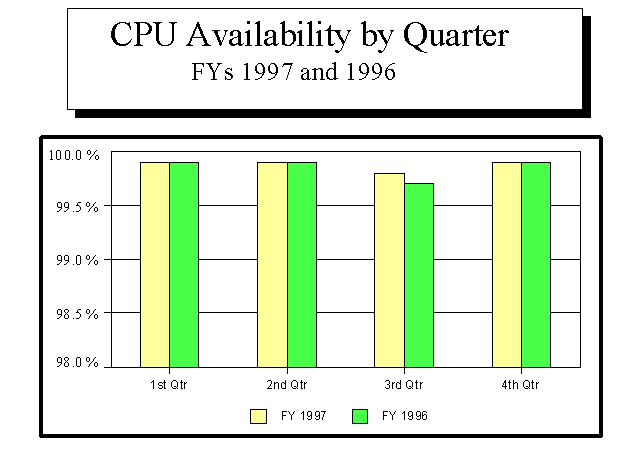
| Quarter | First Quarter | Second Quarter | Third Quarter | Fourth Quarter |
| FY 1997 | 99.9 % | 99.9 % | 99.8 % | 99.9 % |
| FY 1996 | 99.9 % | 99.9 % | 99.7 % | 99.9 % |
FMS - Financial Management Systems
The FMS is responsible for the accounting operation which supports the Departmental Offices, Boards, Divisions and the U.S. Marshals Service (USMS). Effective October 1997, the USMS assumed full responsibility for its financial accounting and operational support.
The FMS also develops and implements Department-wide financial management policies and systems to support planning, programming, budgeting, accounting, and other financial management activities. In addition, this activity provides for the development, enhancement, and maintenance of the Department's Financial Management Information System (FMIS).
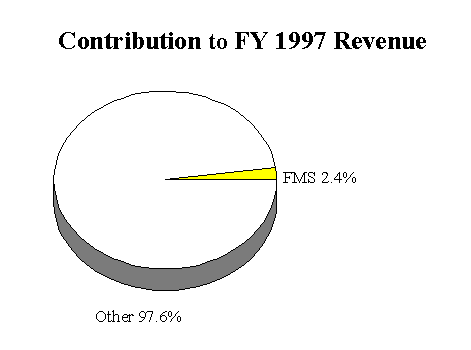
Mission:
To provide financial management and accounting services throughout the Department and to develop a Department-wide, integrated financial management system as required by the Office of Management and Budget (OMB) Circular A-127, Financial Management Systems.
The FMS has submitted the following performance measurement information.
On-time Percentage for Submission of SF-133 (Report on Budget Execution)
Each month the Finance Staff produces numerous required reports for the U.S. Treasury and the OMB. A key report produced each month is the SF-133. During FY 1997, 100 percent of the SF-133s, which exceed 90 in monthly volume, are produced and submitted to the Budget Staff by the 15th workday of each month and electronically transmitted quarterly to the U.S. Treasury via GOALS within the required time frame of the 25th of each month following the end of a fiscal quarter.
Results: 100 percent of the submissions of the SF-133s were within the Budget Staff and U.S. Treasury deadlines for all of FY 1997.
Invoice Processing
The FMS has a complete performance measurement program for invoice processing. At the outset of the program, FMS's management clearly defined the mission, goals, and objectives of the invoice processing operation and effectively communicated this to operations personnel and the customers serviced by this activity. Each month, an office independent of the invoice processing operation conducts a true random sample of invoices processed. The data collected is used to produce management reports that provides statistical data on the performance of operational personnel, and goals and objectives are revised and refined based on the information provided. This performance measurement process has had a very positive impact on program performance as shown in the following charts.
The Fiscal and Data Services Section (FDSS) is part of the DOJ FMS and is responsible for payment processing for the Offices, Boards, and Divisions (OBDs) and the U.S. Marshals Service Headquarters. The dollar figures and transactional volumes presented in the following graphs represent the entire invoice processing business conducted by FDSS which exceed the figures for the WCF presented elsewhere in these financial statements.
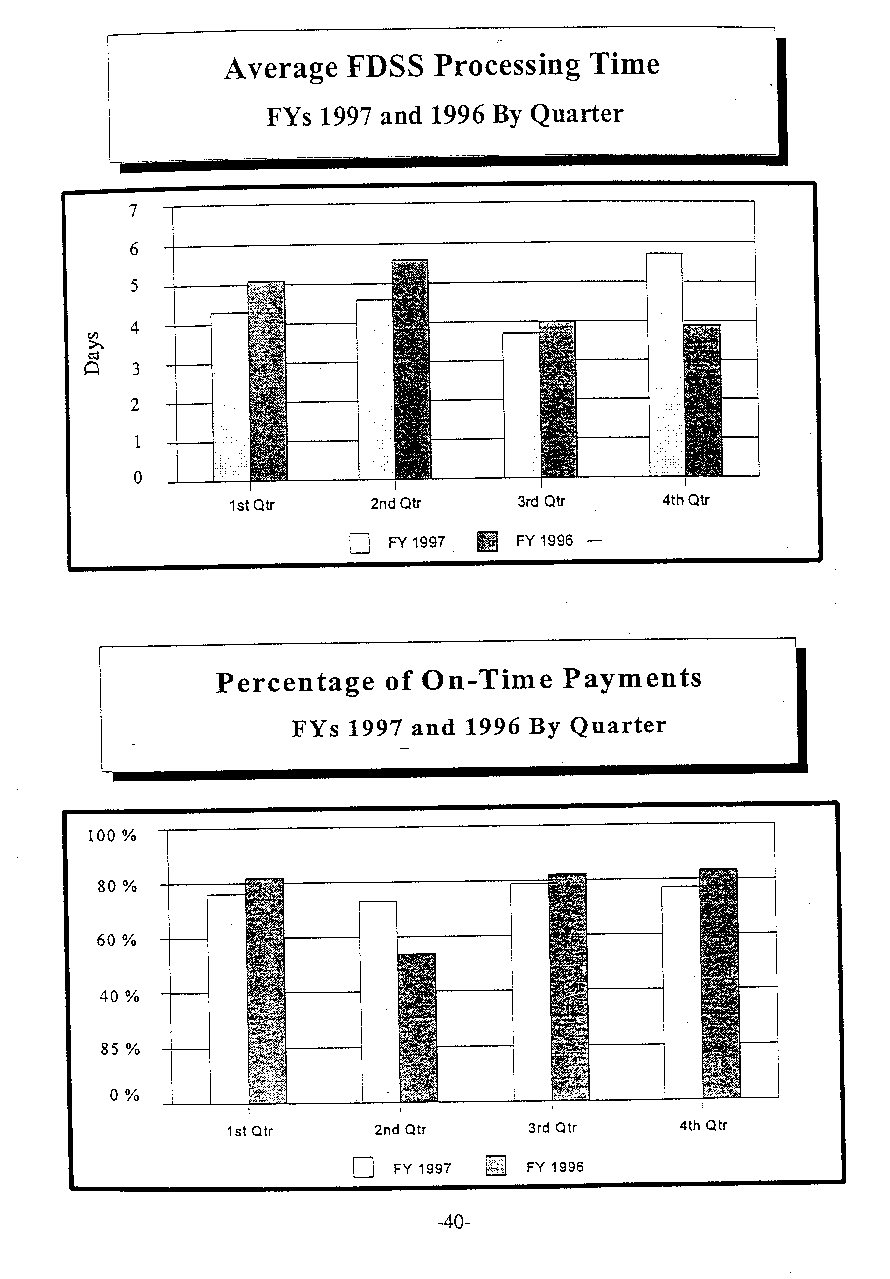
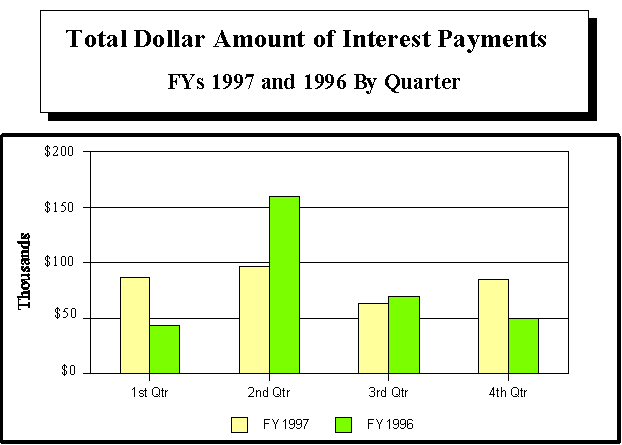
Personnel Services - Drug-Free Workplace
Drug-Free Workplace (DFWP), part of Personnel Services, provides random testing of employees in designated positions and mandatory applicant testing for the OBDs.
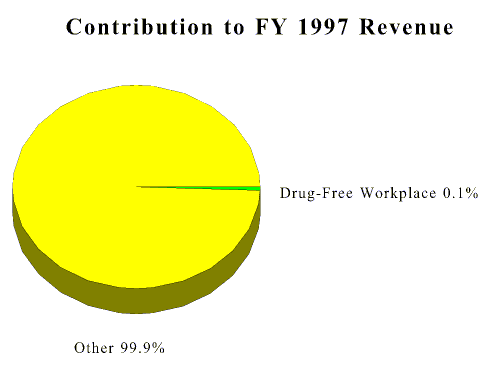
DFWP Mission:
To provide and maintain a Drug-Free work environment for the Department.
The DFWP is a small but integral part of the DOJ commitment to the performance measurement process, and has implemented several performance measurements related to drug testing. Three examples follow:
Applicant Drug Testing
Standard: The DFWP shall ensure that drug testing results are transmitted to the hiring organization to meet staffing deadlines within 7 workdays for local testing and within 10 workdays for field offices.
Results: The DFWP conducted 96.0 percent of all DOJ requests for drug testing
received during FY 1997. Of the tests conducted, 68.8 percent of the test results were
transmitted to the hiring organization to meet staffing deadlines within standards set for
local offices and 83.1 percent for field offices.
| Inputs | Outputs | Outcomes | |
| Number of Collections Requested | Number of Collections Requested | Local Office Results Within 7 Workdays | Field Office Results Within 10 Workdays |
| 3,691 | 3,545 | 837 | 1,788 |
Random Drug Testing
Standard: The DFWP shall conduct drug testing on 7 percent of the on-board employees, especially those designated for testing by the OBDs and approved by the courts.
Results: The DFWP met 72.8 percent of the 7 percent standard or 5.1 percent of
all on-board employees. Each month the number of employees eligible for random testing
changes. This percentage is based on a averaged number of testing designated positions
during FY 1997, in this case 3,500. The actual number of employees tested was 177 For FY
1997, which is 18.4 percent above the 217 employees tested in FY 1996.
| Inputs | Outputs | Outcomes |
| Number of Employees Selected | Number of Employees Tested | Percent of Designated Employees |
| 275 | 177 | 5.1% |
Collection/Specimen Integrity
Standard: The DFWP shall ensure that all collection are done accurately with respect to an individual's privacy and that the chain-of-custody form is properly completed.
Results: The DFWP met this standard 99.4 percent during the reporting period.
OFFICE OF THE INSPECTOR GENERAL, AUDIT DIVISION
ANALYSIS AND SUMMARY OF ACTIONS NECESSARY
TO CLOSE THE REPORT
Recommendation Number:
#####